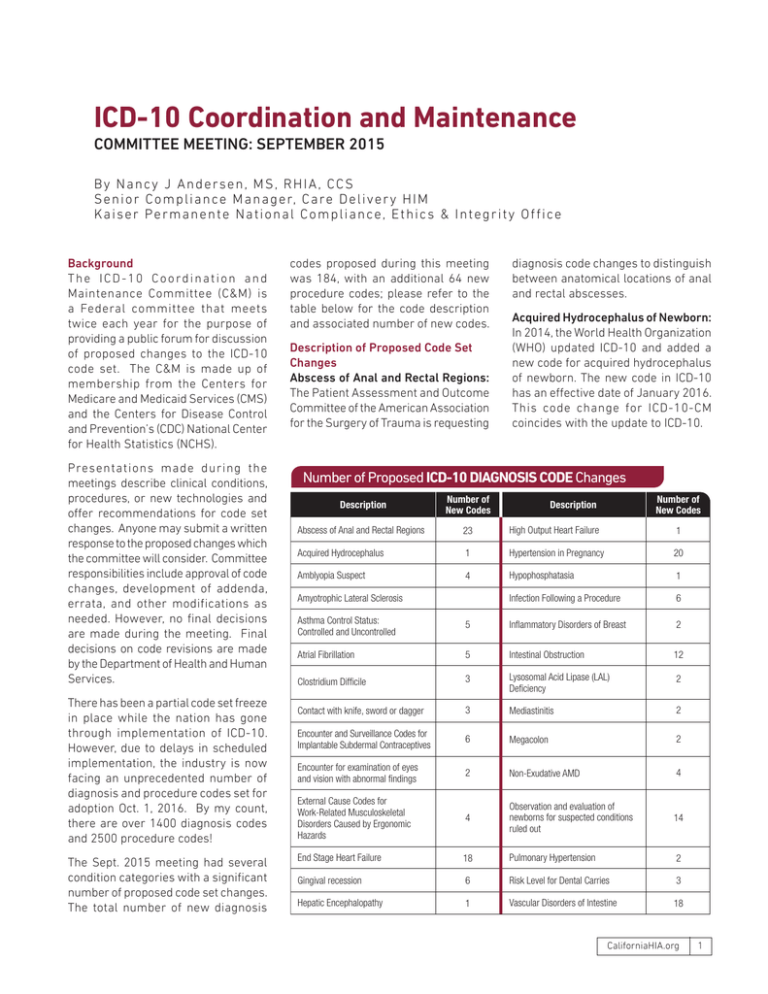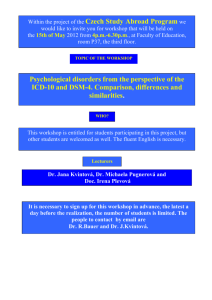ICD-10 Coordination and Maintenance
advertisement

ICD-10 Coordination and Maintenance COMMITTEE MEETING: SEPTEMBER 2015 By Nan cy J Ande rse n, MS, R HIA , C C S S eni or Complianc e Manag er, Care D e l i ve r y H I M Kai s er Permane nt e Nat io nal Co m pl i a nce , E t hi cs & I nt e gr i t y Of f i ce Background T h e I C D - 1 0 C o o rd i n a t i o n a n d Maintenance Committee (C&M) is a Federal committee that meets twice each year for the purpose of providing a public forum for discussion of proposed changes to the ICD-10 code set. The C&M is made up of membership from the Centers for Medicare and Medicaid Services (CMS) and the Centers for Disease Control and Prevention’s (CDC) National Center for Health Statistics (NCHS). Presentations made during the meetings describe clinical conditions, procedures, or new technologies and offer recommendations for code set changes. Anyone may submit a written response to the proposed changes which the committee will consider. Committee responsibilities include approval of code changes, development of addenda, errata, and other modifications as needed. However, no final decisions are made during the meeting. Final decisions on code revisions are made by the Department of Health and Human Services. There has been a partial code set freeze in place while the nation has gone through implementation of ICD-10. However, due to delays in scheduled implementation, the industry is now facing an unprecedented number of diagnosis and procedure codes set for adoption Oct. 1, 2016. By my count, there are over 1400 diagnosis codes and 2500 procedure codes! The Sept. 2015 meeting had several condition categories with a significant number of proposed code set changes. The total number of new diagnosis codes proposed during this meeting was 184, with an additional 64 new procedure codes; please refer to the table below for the code description and associated number of new codes. Description of Proposed Code Set Changes Abscess of Anal and Rectal Regions: The Patient Assessment and Outcome Committee of the American Association for the Surgery of Trauma is requesting diagnosis code changes to distinguish between anatomical locations of anal and rectal abscesses. Acquired Hydrocephalus of Newborn: In 2014, the World Health Organization (WHO) updated ICD-10 and added a new code for acquired hydrocephalus of newborn. The new code in ICD-10 has an effective date of January 2016. This code change for ICD-10-CM coincides with the update to ICD-10. Number of Proposed ICD-10 DIAGNOSIS CODE Changes Description Number of New Codes Abscess of Anal and Rectal Regions 23 High Output Heart Failure 1 Acquired Hydrocephalus 1 Hypertension in Pregnancy 20 Amblyopia Suspect 4 Hypophosphatasia 1 Infection Following a Procedure 6 Amyotrophic Lateral Sclerosis Number of New Codes Description Asthma Control Status: Controlled and Uncontrolled 5 Inflammatory Disorders of Breast 2 Atrial Fibrillation 5 Intestinal Obstruction 12 Clostridium Difficile 3 Lysosomal Acid Lipase (LAL) Deficiency 2 Contact with knife, sword or dagger 3 Mediastinitis 2 Encounter and Surveillance Codes for Implantable Subdermal Contraceptives 6 Megacolon 2 Encounter for examination of eyes and vision with abnormal findings 2 Non-Exudative AMD 4 External Cause Codes for Work-Related Musculoskeletal Disorders Caused by Ergonomic Hazards 4 Observation and evaluation of newborns for suspected conditions ruled out 14 End Stage Heart Failure 18 Pulmonary Hypertension 2 Gingival recession 6 Risk Level for Dental Carries 3 Hepatic Encephalopathy 1 Vascular Disorders of Intestine 18 CaliforniaHIA.org 1 ICD-10 Coordination and Maintenance Amblyopia Suspect: The American Aca d e my o f O p h t h a l m o l o g y i s requesting new codes for amblyopia suspect in order to be able to identify and monitor this condition. Amyotrophic Lateral Sclerosis (ALS): In consultation with neurologists specializing in the diagnosis and care of persons with ALS, the Centers for Disease Control and Prevention’s Agency for Toxic Substances and Disease Registry (ATSDR) is proposing changes to ICD-10-CM to assure that it is possible to distinguish ALS from other motor neuron diseases. Asthma Control Status: Controlled and Uncontrolled: The American Academy of Allergy Asthma and Immunology (AAAAI) proposes to Committee (URC) approved changes to ICD-10 category W25 (Contact with sharp glass), category W26 (Contact with knife, sword or dagger) and category W45 (Foreign body or object entering through skin). These changes will take effect in ICD-10 January 2016. ICD-10-CM will be updated to reflect these changes. Encounter and Surveillance Codes for Implantable Subdermal Contraceptives: The proposed code changes modify the proposal the American Congress of Obstetricians and Gynecologists (ACOG) presented at September 2014 ICD-10 Coordination and Maintenance committee meeting. ACOG proposed new codes for encounters and surveillance Number of Proposed ICD-10 PSC PROCEDURE CODE Changes Number of New Codes Description Branched and Fenestrated Endograft Repair of Aneurysms Cerebral Embolic Protection During Transcatheter Aortic Valve Replacement Description Number of New Codes 42 Intracardiac Pacemaker 22 None at this time - CMS is interested in hearing from the public; this is a new technology procedure Endovascular Repair of Abdominal Aortic Aneurysms via Entire Sac-Sealing CMS does not recommend creation of a new code; pending further information expand code category J45 to add further specificity to distinguish controlled and uncontrolled asthma. Chronic hepatitis vs. hepatitis carrier: The World Health Organization (WHO) made changes in ICD-10, effective January 2016, to deactivate the code Z22.5, Carrier of viral hepatitis. It is proposed to eliminate this subcategory in ICD-10-CM. Cases of hepatitis carrier should be coded to category B18, Chronic viral hepatitis. codes for vaginal ring hormonal and transdermal patch hormonal contraceptive methods. Clostridium Difficile: It is the recommendation of Merck & Company, Inc. that new codes be added under code A04.7, Enterocolitis due to Clostridium, to distinguish between initial vs. recurrent cases of the condition. End Stage Heart Failure, Right Heart Failure, and Biventricular Heart Failure: There is a need to distinguish a d u l t a c u t e a n d c h ro n i c r i g h t ventricular failure (or decompensated), end stage heart disease, and pure left hear failure from the Core Measures requirements of left heart disease, and track patients who have right Contact with knife, sword or dagger: In 2013 the WHO Update Reference 2 CHIA WEB JOURNAL DECEMBER 2015 Encounter for examination of eyes and vision with abnormal findings: The American Academy of Ophthalmology is requesting new codes for an encounter for examination of eyes and vision with abnormal findings in order to be able to identify and monitor this condition. ventricular failure from other than chronic cor pulmonale (which would be coded to I27.81). External Cause Codes for Workrelated Musculoskeletal Disorders Caused by Ergonomic Hazards: The Ohio Bureau of Workers’ Compensation (OHBWC); NIOSH and other members of the ICD-10-CM Ergonomic External Causation Coding Workgroup are requesting expansion of the activity code category to indicate the specific activity of the patient seeking healthcare due to a work-related musculoskeletal disorders (MSD) caused by ergonomic hazards. Gingival recession: The American Aca d e my o f Pe r i o d o n t o l o g y i s requesting the specificity which was in ICD-9-CM be added to ICD-10-CM to differentiate the levels of severity. Hepatic Encephalopathy: Valeant Pharmaceuticals is requesting a new code for Hepatic Encephalopathy, to differentiate less severe hepatic encephalopathy from cases with hepatic coma. High Output Heart Failure: High output heart failure is now indexed to code I50.9, Heart failure, unspecified. Based on multiple inputs, a new code is proposed for high output heart failure. Hypertension in Pregnancy: ACOG is proposing the revision of codes for hypertension in pregnancy. The suggested revisions update the code sections to mirror and standardize the existing language as it is currently reported in code sections O10 and section O15. The requested codes reference conditions complicating childbirth and the puerperium where they currently do not exist. Hypophosphatasia: Alexion Pharmaceuticals requested creation of a unique code for identification of patients with Hypophosphatasia. Recent developments in patient management indicate a need to specifically identify HPP in the encoded data for tracking purposes and to analyze outcomes. ICD-10 Coordination and Maintenance Infection Following a Procedure: The Patient Assessment and Outcome Committee of the American Association for the Surgery of Trauma is requesting the changes to better distinguish the severity of infections following a procedure. Inflammatory Disorders of Breast: The Patient Assessment and Outcome Committee of the American Association for the Surgery of Trauma is requesting the changes to better distinguish mastitis from breast abscesses. Intestinal Obstruction: The Patient Assessment and Outcome Committee of the American Association for the Surgery of Trauma is requesting the changes to better distinguish the severity of intestinal obstruction. Lys o s o m a l Ac i d L i p a s e ( L A L ) Deficiency: Alexion Pharmaceuticals is requesting the creation of a specific code for identification of patients with LAL Deficiency. Mediastinitis: The Patient Assessment and Outcome Committee of the American Association for the Surgery of Trauma is requesting the following tabular changes to better identify Mediastinitis. Megacolon: The ICD-10 Coordination and Maintenance proposed that a new code be created for toxic megacolon. Non-Exudative AMD: The American Academy of Ophthalmology (AAO) is requesting the new codes to better distinguish the stages of non-exudative AMD. Observation and evaluation of newborns for suspected conditions ruled out: The American Academy of Pediatrics (AAP) has developed modifications of its initial proposal presented at the September 2013 C&M meeting. These modifications are based on submitted comments and working with various stakeholders over the last two years. Pulmonary Hypertension: It has been requested by Bayer HealthCare Pharmaceuticals that new codes be created to better represent the current clinical classification of PH. Risk Level for Dental Carries: The American Dental Association (ADA) is proposing the creation of new codes that will assist dentistry with the reporting of detailed caries risk assessment diagnoses. Vascular Disorders of Intestine: The Patient Assessment and Outcome Committee of the American Association for the Surgery of Trauma is requesting the changes to better distinguish the severity of intestinal ischemia with separate codes for both the small and large intestine. Branched and Fenestrated Endograft Repair of Aneurysms: These new procedure codes were requested by the Society of Vascular Surgery to create unique device values to describe branched and/or fenestrated endograft repair for aneurysms that occur in the abdominal or thoracic aorta. and procedure codes proposed for adoption, including that have been waiting for the partial code freeze will be published so stay tuned. With the potential for a “fire hose” of new codes coming our way Oct. 1, 2016, in could be a bumpy ride! References The Centers for Medicare and Medicaid Services ICD-10 Coordination and Maintenance Committee Meeting Materials, Sept. 22-23, 2015. https://www.cms.gov/Medicare/ Coding/ICD9ProviderDiagnosticCodes/ ICD-9-CM-C-and-M-Meeting-Materials. html Centers for Disease Control, ICD10 Coordination and Maintenance Committee, Sept. 22-23, 2015. http:// www.cdc.gov/nchs/icd/icd9cm_ maintenance.htm Intracardiac Pacemaker: St. Jude Medical and Medtronic requested a unique procedure code to describe the insertion of an intracardiac pacemaker, commonly referred to as “leadless pacemaker”, as well as its removal or revision. Summary T h e I C D - 1 0 C o o rd i n a t i o n a n d Maintenance Committee meets twice each year for the purpose of public proposals for changes to the ICD-10 code set. The Sept. 2015 meeting had several proposals with a significant number of new codes, including anal and rectal abscess, end stage heart failure, hypertension in pregnancy, intestinal obstruction, observation and evaluation of newborns for suspected conditions ruled out, vascular disorders of Intestine, branched and fenestrated endograft repair of aneurysms, and intracardiac pacemakers. The Inpatient Prospective Payment System (IPPS) Proposed Rule is expected to be published in April 2016, at which time the list of diagnosis CaliforniaHIA.org 3



